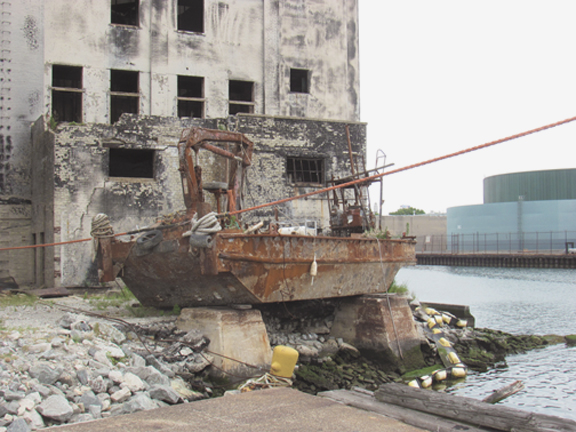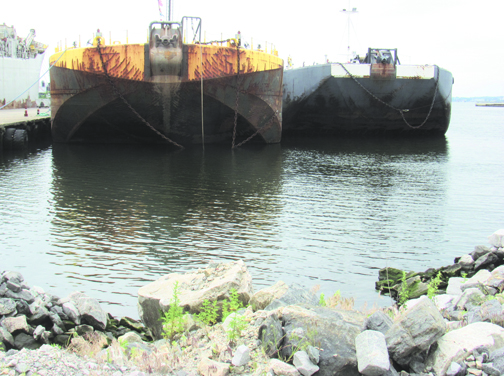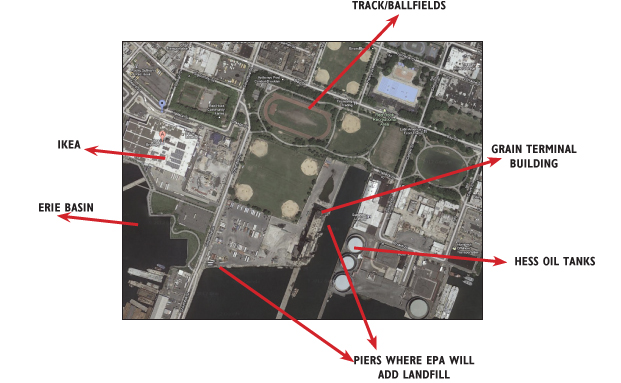As reported in the Star-Revue’s last issue, a contaminated disposal facility (CDF) at the Gowanus Bay Terminal (GBX) in Red Hook is under discussion. The Environmental Protection Agency (EPA) has proposed the stable repository for sludge in its plan for cleanup of the Gowanus Canal.
The giant piece of concrete-like crust, or “monolith,” as Project Manager Christos Tsiamis describes it, would be constructed in water—not on the ground. As an ancillary benefit, the plan creates developable land for the GBX’s owner, John Quadrozzi, Jr. The land’s use would ultimately be the decision of Quadrozzi alone. However, the plan is subject to community acceptance following a public comment period, which is now extended through April 27.
The next public meeting in Red Hook is slated for February 13 at 6:30 pm at PS 15. At a similar meeting in Carroll Gardens on February 11, the plan is not expected to face much controversy, as that community has already largely approved the proposal.
After their January 24 meeting, the EPA left many in Red Hook confused about what was at stake with the proposed plan and who its stakeholders were. Ahead of the February 13 meeting, both Tsiamis and Phaedra Thomas—a paid representative of Quadrozzi—made an effort to clarify the issues.
“The fact is that these issues are technical. We understand that the community has questions, and we respond. Again, this is only one option,” said Tsiamis, who is the plan’s—and the CDF’s—chief architect.
In a phone interview with the Star-Revue, Tsiamis emphasized that the CDF would only use soil dredged from the canal bottom that contains the lowest-grade, non-free-flowing contaminants. Those contaminants—potent atmospheric pollutants known as polycyclic aromatic hydrocarbons (PAHs)—would be coalesced into a solid mixture of sand, dredge and cement with a consistency akin to concrete. This mixture would resemble some PAH-laden varieties of asphalt deemed safe and used to build city streets.

The concentration of PAHs in the material would be about 1/1000 of that found in some asphalts, Tsiamis said. That material would be housed in hardened walls of bentonite after being treated on-site at the GBX. And while the CDF lies in a flood zone, Tsiamis said that the land it covers—and the water it displaces—at the edge of the Gowanus Bay is such that there is no increased risk of flooding.
In a separate interview, Thomas added to these justifications the environmental benefits of keeping as much of the dredge in Red Hook as possible.
“Transporting this material with thousands of trucks consumes an enormous amount of additional fuel emissions,” she said.
Thomas said that Quadrozzi, if given community acceptance of the CDF, is considering plans to build a cement and concrete mixing plant as part of his Quadrozzi Concrete Corporation. He has also discussed the possibility of a community “visioning process” for an “eco-industrial park” on the plot of land created by the CDF, she said.
While Quadrozzi will not be paid by the EPA for deposit of the sludge in the CDF, he stands to gain much liquidity from the increased property values of his assets at the GBX. According to Tsiamis, Quadrozzi’s fines from the State Department of Environmental Conservation for dumping material illegally into the Gowanus Canal “did not present any red flags.”
The $37 million the EPA saves by treating and storing the material on-site in the CDF, meanwhile, will go straight into the pockets of the parties deemed responsible for the pollution, including the City of New York and National Grid.
Tsiamis maintained that project savings are the “last consideration” for his team, and that they “do not impede our progress with the community review.” Beyond technical considerations, Tsiamis also emphasized the jobs that would be created in the community through construction and maintenance of the CDF.
“I’ve been here for three years now, in dozens of meetings with the community. I’ve spoken with people living and fishing around Red Hook. I know the need for employment here,” he said.
As far as a cement factory or an “eco-industrial park,” Tsiamis said it was too early to guess the site’s future use.
“A monolith is what [the CDF] is,” he said. “Once we construct the CDF, it’s up to the owner of the property. He can use it in any way he wants. But when it’s built, there will be restrictions—legal restrictions for things like digging and drilling in that area. And, for instance, restrictions like ‘you cannot build more than one story aboveground.’ For the life of the CDF, the EPA has jurisdiction there.”
Community Review
“Science and engineering are important,” acknowledged Tsiamis, but his team also “does not dismiss sentiment.” Through public meetings, verbal discussion and written comments, community members have the opportunity to voice their support for or dissent from the EPA’s proposed plan using any arguments they see fit. All comments are weighted the same, and everyone is a stakeholder. The EPA, which has already extended the comment period once from 30 to 90 days due to public demand, announced on February 8 it would extend the period another 30 days to April 27.

The February 13 meeting is designed for more detailed explanations of the EPA’s proposed plan. Unlike the January 24 meeting, no stenographer will attend to transcribe formal comments. The EPA will still hold a question and answer period at the end with “no stricture on time—really only until they throw us out of the building,” Tsiamis said, encouraged everyone who could to attend the meeting and comment on the plan.
“We’re miles ahead of the policies enacted by the former Soviet Union,” he said, referring to the EPA’s method of stabilizing PAHs in a CDF, which has been used for decades and most recently at Portland Harbor in Oregon. “But I’m not a city planner. We need to hear as many voices as possible.”










3 Comments
Whoever wrote the captions doesn’t know anything about marine business. The photo captioned “A number of rusting hulks are presently docked” shows two fuel barges from Vane Brothers. Vane boats work steadily and is in excellent condition. The bow rake on barges gets rusty between haul outs at the shipyard but that is just superficial cosmetic stuff.
Thank you for the enlightenment. How do you feel about the EPA proposal?
On February 07, I suggested on FaceBook a possibiity of using the waste dreged soi from the GC after it is cleaned up a little For mfg cement…This cment can be used to raise the bulkheads at the waters edge…The entire westerly portion of Red Hook woud benefir from such a project, since his area was severly impacted by hurricaine Sandy…The flooding was truly monumental and unheard of….My entire life 83 years and I never witnessed such devestation…. The Mayors proposal is to burden homeowners to reconstruct their homes by aising the basements to the street level , using this as their machine room, and them add apther story atop the existing home or property to make up for the lost basment…..This is grossly unfair to property owners and would impose a tremendous burden on them…Additionally, it would discourage new buyers since they would be hit with an immediate extra re construction cost to accomlish this proposal of our mayor….The expense of flood control should be borne Jointly by the City, State, and Federal Government…Not by a small property owner who is suffering through today’s economic atmosphere… JJ Burkard.Red Hook Resident/Homeowner